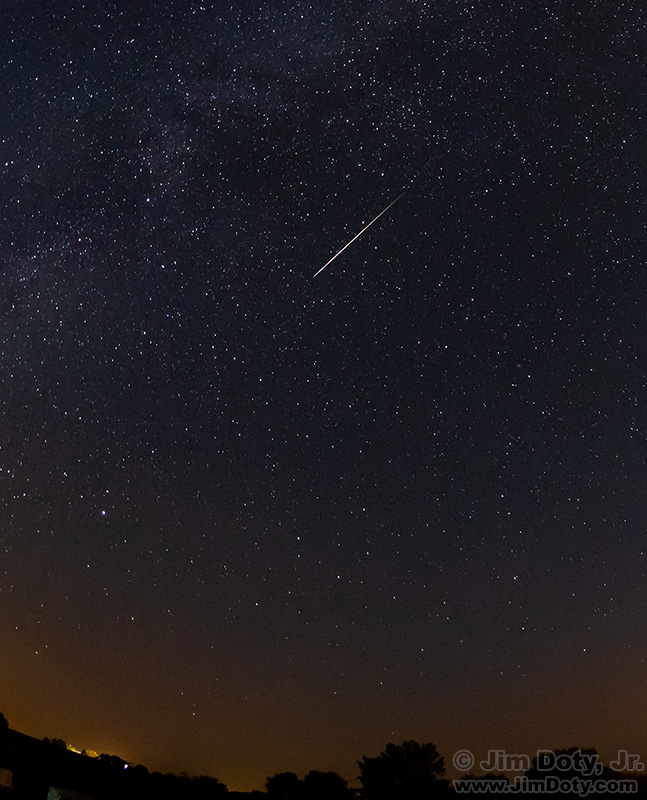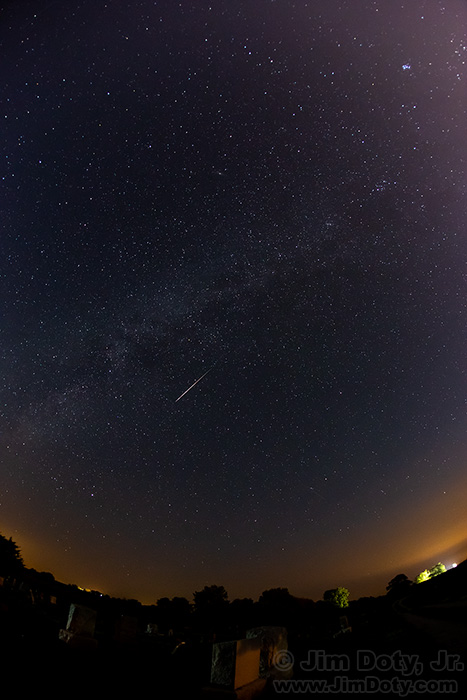
Perseid Meteor photographed from Rose Hill Cemetery west of Lamoni, Iowa. 4:55 am CDT, August 13, 2018. Cropped from the original image.
Tonight, August 11-12, is the predicted peak night of the Perseid Meteor Shower this year. But you can also look for the next few nights. This article will tell you what you need to know to see and photograph the most popular meteor shower of the year.
Here are the basics.
If all goes well (no clouds) and this is a good year, you could see up to you 60 Perseids per hour as it gets closer to dawn.
Get as far away as you can from big city lights. If you are driving away from a city, go east from the city since the Perseids will generally be in the Northeast sky and you want the glow from the city lights behind you.
Put your camera on a tripod. Use a wide angle lens to take in a wide area of sky.
Manually focus the lens on infinity. That can be tricky for night photography. Read this article for help.
Start with these settings: ISO 3200. Aperture of f/4. Shutter set at 30 seconds.
Take a few test pictures to test your exposure settings, even if you don’t see any meteors. If the sky glow (background) is too bright due to the moon, try ISO 1600 or 800 or 400 (or cut the shutter speed from 30 to 15 seconds). If the meteors/stars are too dim, try ISO 6400 or higher.
Where should you look and point your camera? Meteors can appear anywhere in the night sky, but generally look to the northeast. The Perseid meteors appear to radiate from the constellation Perseus, for which the shower is named. If you have Stellarium for your computer (it is a free download and well worth having), the “Planets” app for your smartphone (or a similar night sky app), or a planisphere, or star charts, figure out where Perseus is in the night sky and point your camera generally in that direction. Perseus will be close to the northeast horizon at 11 pm local time and climber higher in the northeast sky as the night goes on.
What is the best time? Between midnight (the beginning of August 12) and 5 am. The shower usually gets better throughout the night and be at its best in the hours before dawn. Expect to see a meteor on the average of once every 1 to 2 minutes in the early morning hours.
Don’t wait to see a meteor before you open the shutter. Just take one picture right after another until you get something. Check your exposure, adjust the ISO if necessary, and do it again.
If it is cloudy where you live the night of August 11-12, try again on another night between midnight and 5 am local time. The Perseids will last a week or so after the peak night, but the meteors will be less frequent the farther away you get from the peak night.
A wide angle lens increases your odds of photographing a meteor. Although meteors appear to radiate from a specific area of the sky, they can show up anywhere in the sky. A wide angle lens does mean the streak of the meteor across the sky will look smaller, but you can always crop the original image, as I did for the image at the top of this article. The original, uncropped image is below.
Take a lens cleaning cloth or lens cleaning tissues with you. Dew can be an issue on warm summer nights and dew forming on the front of your lens can be a problem. You will need to be able to remove the dew from your front lens element or filter.
Be sure to check out the links at the end of the article.
Photo Data: Canon 5D Mark III. Canon EF 15mm lens. f/4.5, 30 seconds, ISO 3200.
Links
Perseid Meteor Shower 2024: all you need to know – at EarthSky.org
How To Focus Your Lens on Infinity for Night Photography
How To Use a Planisphere – with additional information on Stellarium software for your computer and the Planets app for smartphones.
Stellarium – a free download for Linux, Mac OS X, and Windows
Stellarium – as a web based app

